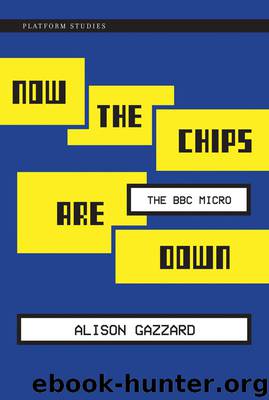Now the Chips Are Down: The BBC Micro (Platform Studies) by Gazzard Alison

Author:Gazzard, Alison [Gazzard, Alison]
Language: eng
Format: mobi, epub
ISBN: 9780262034036
Publisher: The MIT Press
Published: 2016-02-18T16:00:00+00:00
Developing Elite
Even now, just a week after its launch, Elite has already firmly established itself as a cult game for the Beeb that seems to create its own self perpetuating fame.
David Fell, “Elite—An Outstanding New Game from Acornsoft,” Beebug, November 1984
The BBC Micro as a potential site for game creation created a bond between David Braben and Ian Bell. A chance meeting at Cambridge University and a shared interest in Acorn’s microcomputing platforms led the duo to create Elite, one of the best-known games for the Micro.21 Braben, unable to afford a Micro at the time, had to use his personally modified Acorn Atom. “The only other low cost machine at that time,” he later noted, “was the Sinclair ZX80. It was nowhere near as good and not dramatically cheaper (the starting price for an Acorn Atom was £120, whereas for a ZX80 it was £99).”22 The Atom and David Johnson-Davies’ book Atomic Theory and Practice gave Braben his first tastes of programming. The book, he recalled, “was very helpful in learning to program in BASIC.”23 Therefore, even though Braben didn’t own a BBC Micro at the time, he was already acquainted with the fundamental principles of how to develop a game for that machine as a result of his experiences with other Acorn hardware. In a time of game creation where many releases were built on arcade game clones, Braben started to think about other potential game projects.24 “I played some games on arcade machines—for example in a local chip shop,” he recalled, “but there were relatively few games around (on any platform) that weren’t arcade games or arcade game clones.”25 However, Braben wasn’t interested in arcade-style games or in the ports that were available on the BBC Micro. He wanted a longer game experience, the chance for players to explore larger worlds and not just gain points from shooting or collecting things. The idea that points only equated to extra lives was also something he was not fond of, and subsequently he wanted to think about other ways of creating game content. It was this drive, along with meeting Ian Bell, that led to the creation of Elite.
Histories of gaming often cite Elite as the “first three-dimensional game.” “In the same way that Cyan had plenty of previous experience to prepare them for producing Myst,” Andrew Hutchison writes, “id Software had released Hovertank 3D in 1991 with the claim that it was the first ever personal computer game with 3D elements (id Software, 2005). This claim has been contested, and the game Elite (Braben Bell, 1984) has been presented as an earlier example (Wikipedia, 2005).”26 However, some discussions of what were earlier three-dimensional games go back to Battlezone in 1980 and 3D Monster Maze in 1981.27 Whereas 3D Monster Maze (programmed for the Sinclair ZX81) had raster graphics, Battlezone had vector graphics. Braben and Bell used vector graphics for Elite. In an interview conducted in 2012, the BBC news presenter Rory Cellan-Jones stated that Elite was three-dimensional in
Download
Now the Chips Are Down: The BBC Micro (Platform Studies) by Gazzard Alison.epub
This site does not store any files on its server. We only index and link to content provided by other sites. Please contact the content providers to delete copyright contents if any and email us, we'll remove relevant links or contents immediately.
Mastering Bitcoin: Programming the Open Blockchain by Andreas M. Antonopoulos(2973)
Dawn of the New Everything by Jaron Lanier(2730)
Blockchain: Ultimate Step By Step Guide To Understanding Blockchain Technology, Bitcoin Creation, and the future of Money (Novice to Expert) by Keizer Söze(2433)
Alibaba by Duncan Clark(2031)
Foundations of Blockchain by Koshik Raj(1942)
Owning Bitcoin: The Illustrated Guide to Security, Privacy, and Potential by Apodaca Richard(1927)
Significant Zero by Walt Williams(1922)
The Mastermind by Evan Ratliff(1893)
Mastering Blockchain by Imran Bashir(1824)
Bitcoin: The Basics of Blockchain and Investing in Cryptocurrency by K. Connors(1774)
Bitcoin: The Ultimate Guide to the World of Bitcoin, Bitcoin Mining, Bitcoin Investing, Blockchain Technology, Cryptocurrency (2nd Edition) by Ikuya Takashima(1657)
Attack of the 50 Foot Blockchain by David Gerard(1646)
The Bitcoin Standard: The Decentralized Alternative to Central Banking by Saifedean Ammous(1625)
Turing's Cathedral by George Dyson(1617)
Cryptocurrency by Neil Hoffman(1599)
Shaping the Fourth Industrial Revolution by Klaus Schwab & Nicholas Davis & Satya Nadella(1584)
The Bitcoin Guidebook by Ian DeMartino(1568)
Dawn of the New Everything: Encounters with Reality and Virtual Reality by Jaron Lanier(1568)
Bill Gates by Michael Becraft(1521)
